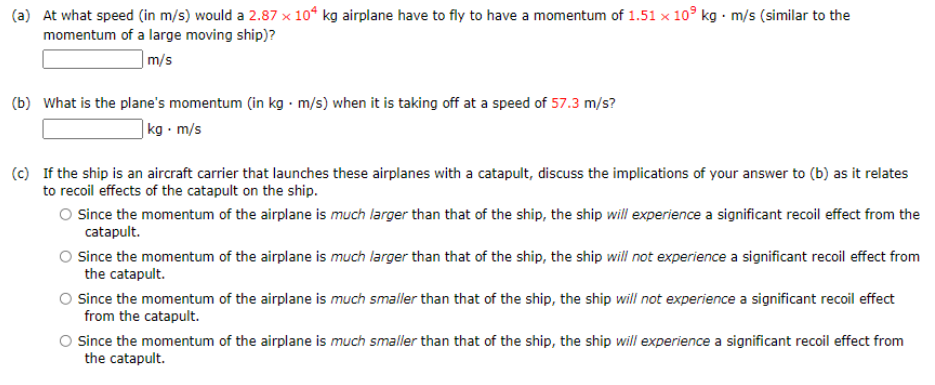At what speed (in m/s) would a 2.87 x 10* kg airplane have to fly to have a momentum of 1.51 x 10° kg - m/s (similar to the momentum of a large moving ship)? ]m/s What is the plane's momentum (in kg - m/s) when it is taking off at a speed of 57.3 m/s? ] kg - m/s If the ship is an aircraft carrier that launches these airplanes with a catapult, discuss the implications of your answer to (b) as it relates to recoil effects of the catapult on the ship. O Since the momentum of the airplane is much larger than that of the ship, the ship will experience a significant recoil effect from the catapult. O Since the momentum of the airplane is much larger than that of the ship, the ship will not experience a significant recoil effect from the catapult. O Since the momentum of the airplane is much smaller than that of the ship, the ship will not experience a significant recoil effect from the catapult. O Since the momentum of the airplane is much smaller than that of the ship, the ship will experience a significant recoil effect from the catapult.
At what speed (in m/s) would a 2.87 x 10* kg airplane have to fly to have a momentum of 1.51 x 10° kg - m/s (similar to the momentum of a large moving ship)? ]m/s What is the plane's momentum (in kg - m/s) when it is taking off at a speed of 57.3 m/s? ] kg - m/s If the ship is an aircraft carrier that launches these airplanes with a catapult, discuss the implications of your answer to (b) as it relates to recoil effects of the catapult on the ship. O Since the momentum of the airplane is much larger than that of the ship, the ship will experience a significant recoil effect from the catapult. O Since the momentum of the airplane is much larger than that of the ship, the ship will not experience a significant recoil effect from the catapult. O Since the momentum of the airplane is much smaller than that of the ship, the ship will not experience a significant recoil effect from the catapult. O Since the momentum of the airplane is much smaller than that of the ship, the ship will experience a significant recoil effect from the catapult.
Physics for Scientists and Engineers: Foundations and Connections
1st Edition
ISBN:9781133939146
Author:Katz, Debora M.
Publisher:Katz, Debora M.
Chapter10: Systems Of Particles And Conservation Of Momentum
Section: Chapter Questions
Problem 4PQ: A mother pushes her son in a stroller at a constant speed of 1.52 m/s. The boy tosses a 56.7-g...
Related questions
Topic Video
Question
100%

Transcribed Image Text:(a) At what speed (in m/s) would a 2.87 x 10° kg airplane have to fly to have a momentum of 1.51 × 10° kg m/s (similar to the
momentum of a large moving ship)?
|m/s
(b) What is the plane's momentum (in kg · m/s) when it is taking off at a speed of 57.3 m/s?
|kg • m/s
(c) If the ship is an aircraft carrier that launches these airplanes with a catapult, discuss the implications of your answer to (b) as it relates
to recoil effects of the catapult on the ship.
O Since the momentum of the airplane is much larger than that of the ship, the ship will experience a significant recoil effect from the
catapult.
Since the momentum of the airplane is much larger than that of the ship, the ship will not experience a significant recoil effect from
the catapult.
Since the momentum of the airplane is much smaller than that of the ship, the ship will not experience a significant recoil effect
from the catapult.
O Since the momentum of the airplane is much smaller than that of the ship, the ship will experience a significant recoil effect from
the catapult.
Expert Solution
This question has been solved!
Explore an expertly crafted, step-by-step solution for a thorough understanding of key concepts.
This is a popular solution!
Trending now
This is a popular solution!
Step by step
Solved in 2 steps with 2 images

Knowledge Booster
Learn more about
Need a deep-dive on the concept behind this application? Look no further. Learn more about this topic, physics and related others by exploring similar questions and additional content below.Recommended textbooks for you

Physics for Scientists and Engineers: Foundations…
Physics
ISBN:
9781133939146
Author:
Katz, Debora M.
Publisher:
Cengage Learning

College Physics
Physics
ISBN:
9781305952300
Author:
Raymond A. Serway, Chris Vuille
Publisher:
Cengage Learning

Principles of Physics: A Calculus-Based Text
Physics
ISBN:
9781133104261
Author:
Raymond A. Serway, John W. Jewett
Publisher:
Cengage Learning

Physics for Scientists and Engineers: Foundations…
Physics
ISBN:
9781133939146
Author:
Katz, Debora M.
Publisher:
Cengage Learning

College Physics
Physics
ISBN:
9781305952300
Author:
Raymond A. Serway, Chris Vuille
Publisher:
Cengage Learning

Principles of Physics: A Calculus-Based Text
Physics
ISBN:
9781133104261
Author:
Raymond A. Serway, John W. Jewett
Publisher:
Cengage Learning

University Physics Volume 1
Physics
ISBN:
9781938168277
Author:
William Moebs, Samuel J. Ling, Jeff Sanny
Publisher:
OpenStax - Rice University

Modern Physics
Physics
ISBN:
9781111794378
Author:
Raymond A. Serway, Clement J. Moses, Curt A. Moyer
Publisher:
Cengage Learning

Classical Dynamics of Particles and Systems
Physics
ISBN:
9780534408961
Author:
Stephen T. Thornton, Jerry B. Marion
Publisher:
Cengage Learning